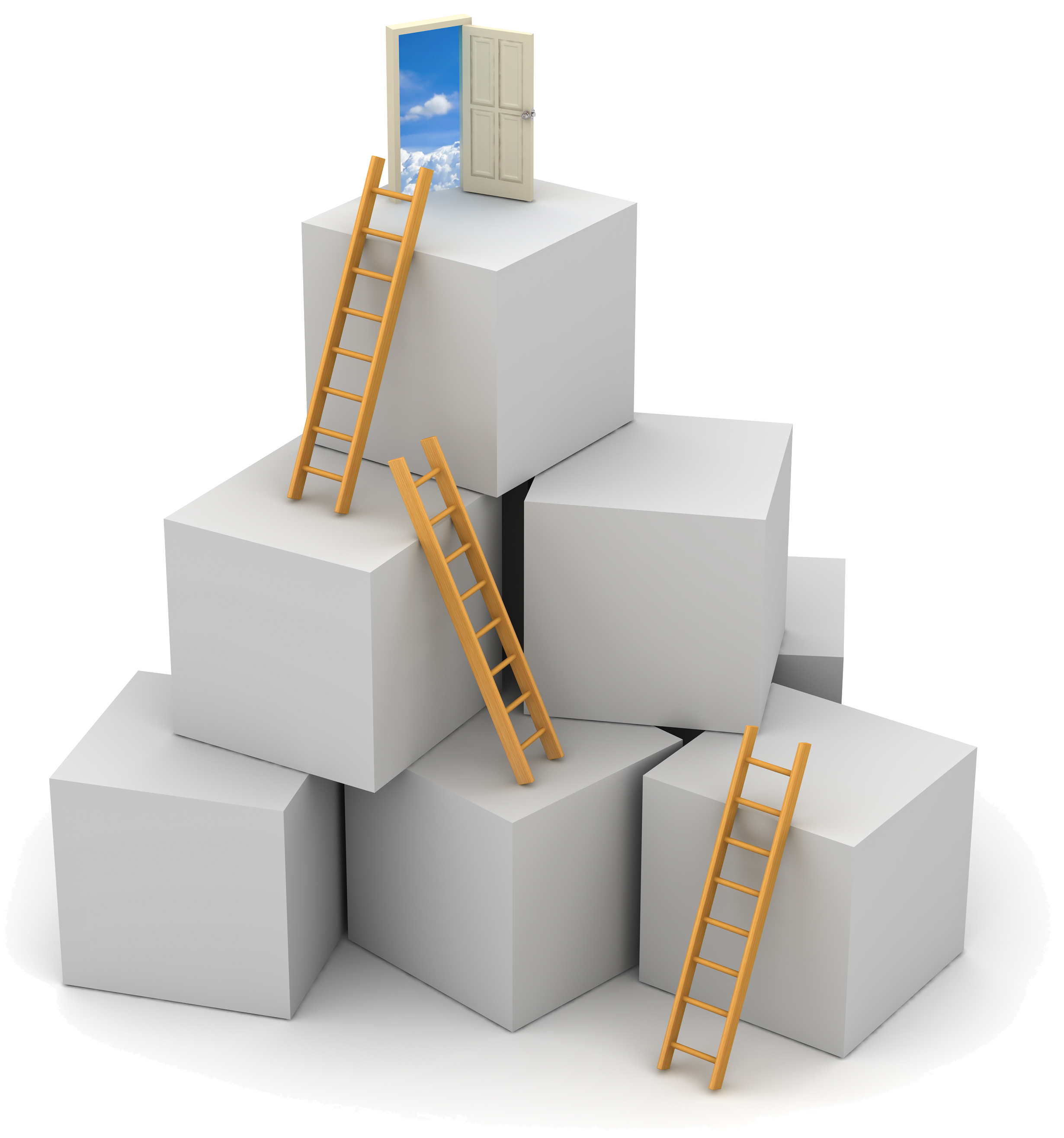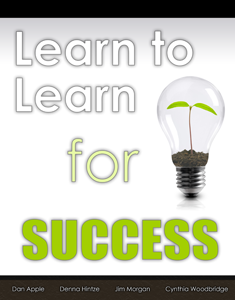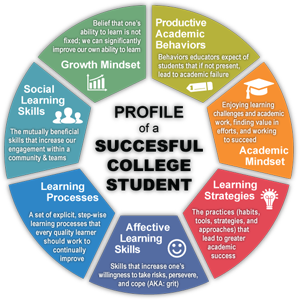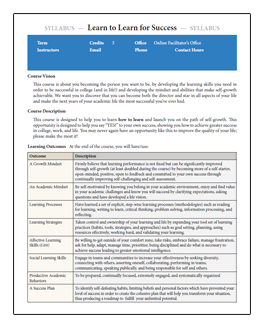
Whether you want to put your best foot forward or regain your footing, this course can help make it happen. Learning to succeed, especially academically, requires learning how to learn as well as learning how to consistently improve your ability to learn. This 4-week asynchonous online course takes 50 to 70 hours.
We invite you to explore this site and then, when you're ready, register for the course
Course Curricula
The Learn to Learn to Succeed curriculum prepares students for academic, work, and life success. This text was initially developed as a way to recreate the Learning to Learn Camp experience in a 3-credit course. As such, it is a perfect fit for the Learn to Learn to Succeed course. The text consists of 19 learning experiences, all of which students complete in the 4-week course.

- Performing Like a Star
- Becoming a Master Learner
- My Past Doesn’t Define My Future
- Self-Assessment: The Engine of Self-Growth
- Time, Planning, & Productivity
- Building and Maintaining Healthy Relationships
- Methodologies: Unlocking Process Knowledge
- Reading for Learning
- Visioning My Future by Exploring My Environment
- Financial Health: Managing Personal Finances
- Performing in Teams and Within a Community
- Performing While Being Evaluated
- Metacognition: Thinking About My Thinking
- Making Failure a Stepping Stone to Success
- Optimizing Physical, Mental, & Emotional Health
- Choosing and Using Mentors Effectively
- Defusing and Using Evaluation
- Shifting from Extrinsic to Intrinsic Motivation
- Becoming a Self-Grower
Course Outcomes

Learners in the 4-week course are expected to make significant progress in all 50 characteristics that make up the Profile of a Successful College Student.
Sample Syllabus
Please understand that the syllabus and schedule available here are based on a previous iteration of the course. As such, they will not be exactly the same as for future courses.Generic syllabus and schedule (pdf)

Participant Work Products
Participants in 4-week course create a Success Portfolio consisting of the following items and their approximate page count:
- Learning Journal (25 pages)
- Assessment Journal (40 pages)
- Life Vision (20 pages)
- Success Plan (10 pages)
- Self-Growth Paper (4 pages)
The Research
5 artices: The Critical Pieces
- Learning-to-Learn Camps: Their History and Development (pdf)
- Learning How to Learn: Improving the Performance of Learning (pdf)
- Identifying At-Risk Factors That Affect College Student Success (pdf)
- What is Self-Growth? (pdf)
- Key Learner Characteristics that Produce Academic Success (pdf)
The Longer Story...
Pacific Crest used 25 years of research and practice of the Academy of Process Educators to integrate Learning to Learn, Self-Growth, and Process Education philosophy in the design and implementation of the Learn to Learn for Success course.
The theory developed for Learning to Learn started in 1990 and has advanced through 20 years of Learning to Learn Camps’ implementations and research. One of the earliest papers, Everyone Can Learn to Learn (1993), articulated that learning can be improved by implementing the philosophy of Process Education and its ten principles and the Classification of Learning Skills. The Learning Process Model followed by the Learning Process Methodology became the critical, explicit representation of how people learn. As Learning to Learn was combined with the Theory of Performance, learning began to be viewed and presented as a performance and the components of learning performance were clarified in Learning How to Learn: Improving the Performance of Learning.
Process Educators identified in the mid 1990’s the need to create a freshmen experience in a paper called a Foundations Course for Learning. The next year a team transformed the Learning Through Problem Solving curriculum into the Foundations of Learning (1995) and this curriculum advanced over the next 20 years. A book, Learning to Learn - Becoming a Self-Grower (2013), was developed upon request from current users of the Learning to Learn Camps to reverse engineer the Learning to Learn Camp into a course. It is this curriculum that has become the basis for Learn to Learn for Success. The course was then adapted in an online implementation.
In parallel, Process Educators discovered that the creation of a quality learning environment and a growth culture is essential. The Transformation of Education illustrates the different aspects of educational culture and the associated transformations needed to create a learning and growth culture. The Impact of Higher Education Culture on Student Mindset and Success articulates the reasons why students’ current mindsets lead to risk factors and why the transformation of culture leads to the development of Key Learner Characteristics for Academic Success that mitigate risk factors. The Professional’s Guide to Self-Growth (2018) documents how transformational Learn to Learn for Success can be.
Another major component of Learn to Learn for Success is based upon the growth mindset and the Process Education mindset of self-development. The history of the language, practices, processes, and scholarship of Process Education describes how important self-growth capability is to success in life. There are ten components defined in What is Self-growth? that are integrated in the course to produce self-growth. Self-assessment and reflection on performance using tools such as a Learning Assessment Journal illustrate how powerful they are in producing self-growth. The Life Vision Portfolio (2002) helps the learners clarify their passion, how to use mentors, and also illuminates the many ways of self-challenging in the GVSU Recovery Course. The design has the students producing an Academic Success Plan that requires students to clarify the expectations and performance criteria of courses to be re-taken and develops detailed course learning and success plans. The self-growth papers illustrate that students have developed emotional intelligence and grit to achieve a high level of success.
Learn to Learn for Success uses the theory behind Learning by Performance to advance students’ learning performance. Students develop 20 Academic Performance Areas such as Reflecting, Reading for Learning, Self-assessing, Critical Thinking, and Problem-solving to elevate learning performance. Learn to Learn for Success uses Cuseo's Seven Universal and Perennial Principles of Student Learning and Persistence to increase students’ future success. Most importantly, Learn to Learn for Success closes the College Readiness Gap. Implementation of Learn to Learn for Success uses the research on Improving Performance, Developing Growth Capability, and the years of expertise for Implementing a Learning to Learn Experience.
A major component in the success of a Learn to Learn for Success course and its outcomes is the performance of the facilitator. The Faculty Guidebook (2007) has a whole section on facilitation that includes a profile of a quality facilitator, how to identify learner needs, and a process for creating facilitation plans. The guidebook also has a section on mentoring that explains how to do constructive interventions. The facilitator uses the Mentoring Methodology to implement many of the 100 Best Practices for Teaching Learning to Learn and Self-Growth. Pacific Crest has developed 23 professional development institutes to support the development of learning to learn facilitators and Online Teaching Learning to Learn Institute.
